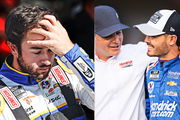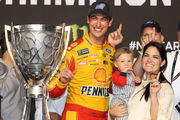
via Imago
NASCAR, Motorsport, USA Cup Practice & Qualifying Aug 12, 2023 Speedway, Indiana, USA NASCAR Cup Series driver Brad Keselowski 6 during practice for the Verizon 200 at the Brickyard at Indianapolis Motor Speedway Road Course. Speedway Indianapolis Motor Speedway Road Course Indiana USA, EDITORIAL USE ONLY PUBLICATIONxINxGERxSUIxAUTxONLY Copyright: xMikexDinovox 20230812_mcd_ad4_17

via Imago
NASCAR, Motorsport, USA Cup Practice & Qualifying Aug 12, 2023 Speedway, Indiana, USA NASCAR Cup Series driver Brad Keselowski 6 during practice for the Verizon 200 at the Brickyard at Indianapolis Motor Speedway Road Course. Speedway Indianapolis Motor Speedway Road Course Indiana USA, EDITORIAL USE ONLY PUBLICATIONxINxGERxSUIxAUTxONLY Copyright: xMikexDinovox 20230812_mcd_ad4_17
The Night Race at Bristol promised much but delivered little. Despite Kyle Larson’s impressive 462-lap lead, fans craving an exciting race were left underwhelmed by hours of uneventful action. Now, NASCAR faces a challenge: how to make short-track races more competitive.
And our very own NASCAR legend, Brad Keselowski, took to X to offer a potential solution. He reminisced about how his dominance inspired NASCAR to make changes in the past. However, fans remain skeptical, believing the alterations made to Bristol in 2012 aren’t the answer to improving racing in 2024.
ADVERTISEMENT
Article continues below this ad
How Brad Keselowski’s encouraged changes to the Bristol track
Keselowski is no stranger to dominating Bristol like Kyle Larson’s recent performance on the track. Brad Keselowski enjoyed a similar status on the same track over a decade ago, as the debate around Kyle Larson led him down memory lane to his own era of dominance. Back in 2012, during the Spring Bristol race, Keselowski led for 245 laps before taking the win. Although Keselowski didn’t make it into the playoffs, it was enough for Speedway Motorsports, the company that manages NASCAR circuits, to sanction a massive change for the track. Just a few weeks after Keselowski’s dominant victory, a million-dollar diamond-grinding project was undertaken. Considering the surface was set in place over 5 years ago in 2007, it seemed like a logical decision. However, it changed the essence of the track.
Bristol Motor Speedway is renowned for its aggressively banked turns. Historically, the banking, particularly around the top, reached angles of up to 30 degrees. This distinctive feature defined the track ever since its addition to NASCAR’s schedule. But what diamond-grinding did was remove roughly 1.5 inches from the track, meaning the banking changed for good. Specifically, the steep 30-degree incline was reduced to a 28-degree angle.
Catching up on post @ItsBristolBaby discourse on X.
All I can say is- after leading 245 laps and winning the spring 2012 race with the old cup car; this was the result-https://t.co/fRyiRdI7wK
— Brad Keselowski (@keselowski) September 27, 2024
The idea behind the diamond-grinding was to improve grip levels around the track and encourage competitive racing. To an extent, it did the job. After the track went through the changes, the 2012 August Bristol race painted a different picture. Denny Hamlin got his first-ever Cup Series win in Bristol, kicking off his era of dominance at the track. The race became one of the most famous events in NASCAR history. The numbers too proved competitive racing was back. Compared to the 6 drivers who led the race in March, the August race had 13 different race leaders! Moreover, no driver led for more than 150 laps. All in all, it seemed Speedway Motorsports’ experiment paid off.
Cut to a decade after the change, a near repeat of events took place, except Kyle Larson massively scaled up the level of his lead. Considering the visible effects from 2012, wouldn’t a repeat of such experiments be good for competition in the sport today? Well, the fans certainly don’t think so.
What’s your perspective on:
Brad Keselowski's right—NASCAR's Bristol changes were a disaster. Agree or disagree?
Have an interesting take?
Trending
Fans brutally bash Keselowski’s indirect suggestion for improving short-track racing
After Brad Keselowski recalled the diamond-grinding change on X, NASCAR fans on Reddit quickly took notice, and they weren’t happy at all. While the diamond-grinding experiment worked out in 2012, there’s no guarantee it will work out again. The changes to the track took place 12 years ago, at a time when the sport was much different from what it is today. Moreover, last weekend’s race at Bristol showed the effect of experimentation. Although Goodyear retained the tire strategy that produced an exciting Spring Bristol race, its continued experimentation, specifically the use of PJ1 to enhance grip levels, resulted in a lackluster September event. This fan’s reaction perfectly summed the situation up, as they said, “I wonder if SMI could gaslight everyone, or get them to gaslight themselves I guess. Say they are replacing the surface to the exact specs it used to be, and all of a sudden it’s the greatest racing in the world again, even though nothing would probably change.”
Moreover, it’s not just about the track. The bigger variable is the car being driven. 2012 was a very different era, and most importantly, it didn’t have the Next-Gen car. The current generation of NASCAR vehicles is notorious for not being liked by fans and drivers alike. In NASCAR’s pursuit of parity between teams, overtaking is much more difficult, and when it comes to short tracks, being able to overtake is key to track position. Hence, many fans hold the Next-Gen car to blame. One fan explained in frustration, “People are failing to realize it isn’t a dominance issue. It’s a crappy car that can’t pass on short tracks because everyone is going the same speed.’
ADVERTISEMENT
Article continues below this ad
Even those fans advocating for a return to Bristol’s former 30-degree banking glory believe that the root issue lies with the Next-Gen cars. Moreover, they believe that reversing the track changes would not be sufficient to improve racing, given the current car design. One fan explained, “You know what? I miss the old Bristol where the only fast line was the bottom and that made things exciting because bumps and runs were necessary. It wouldn’t work with this car though. Shit happens. On to Kansas.” The only way forward, as this fan believes, is for the NASCAR community to make their peace with it.

USA Today via Reuters
NASCAR, Motorsport, USA Bass Pro Shops Night Race, Sep 17, 2022 Bristol, Tennessee, USA General view during the NASCAR Bass Pro Shops Night Race at Bristol Motor Speedway. Mandatory Credit: Randy Sartin-USA TODAY Sports, 17.09.2022 20:04:51, 19068110, NPStrans, Nascar, Bristol Motor Speedway PUBLICATIONxINxGERxSUIxAUTxONLY Copyright: xRandyxSartinx 19068110
Some fans blame the lack of cautions and wrecks, not Kyle Larson’s dominance, for the monotonous racing. Another frustrated fan pointed out, “I’m telling you if we saw Larson lead all 500 laps but the race has 10-15 cautions and was chaotic behind him everyone would’ve been fine with it.”
ADVERTISEMENT
Article continues below this ad
According to one Redditor, the root of fans’ outrage is simpler: disappointment that their favorite driver didn’t take the checkered flag. “Are people ever going to stop b*tch*ng about this? Is Kyle Larson dominating a race so infuriating to the incels here whose average/washed driver never wins?” As hard as it may be to accept it, on many occasions, it’s the reason fans find themselves outraged by a race’s monotony.
Regardless, holding one fan’s words to heart, we move on to Kansas, hoping that the 12 drivers would battle it out differently than Bristol.
Have something to say?
Let the world know your perspective.
ADVERTISEMENT
ADVERTISEMENT
ADVERTISEMENT






Debate
Brad Keselowski's right—NASCAR's Bristol changes were a disaster. Agree or disagree?